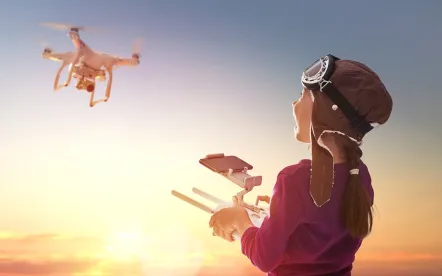Recently, the Federal Aviation Administration (“FAA”) accepted comments on the future of small Unmanned Aircraft Systems (“UAS”), those aircraft under 55 pounds that we commonly refer to as “drones.” The FAA has authorized UAS operations for several years, but many industries have been dissatisfied with the level of allowable use and have pressed the agency to further clarify the circumstances under which operations are allowed. Sports leagues have joined this group.
More than 2,700 comments were filed from across industry, government, and the general public. Of these, one comment was filed jointly by major outdoor sports leagues and associations. The NFL, MLB, NASCAR, and NCAA (the “Leagues”) expressed concern with the FAA’s policies towards UAS and requested greater expansion of UAS pilot responsibilities. FAA’s rules require that UAS be operated by licensed pilots, though the requirements to obtain that licensure are less rigorous than for pilots operating manned aircraft.
One of two FAA proceedings is a Notice of Proposed Rulemaking (“NPRM”), proposing new rules to facilitate additional UAS operations sought by various industries. The second, an Advanced Notice of Proposed Rulemaking (“ANPRM”) on the Safe and Secure Operations of Small Unmanned Aircraft Systems, considers how the FAA should develop rules in response to public safety and national security concerns related to UAS.
The NPRM’s proposal includes:
-
Allowing operations over people, based on the “category” of the UAS being used; and
-
Expanding to a broader range of law enforcement officers and federal authorities the requirement that pilots make available their credentials, while replacing some required pilot testing with training.
In response, the Leagues ask that the FAA specifically note that operations of UAS at night must comply with rules generally applicable to aircraft, which the Leagues assert is axiomatic in logic but not explicitly stated. Second, they ask the FAA to consider expanding the proposed requirement that pilots make their credentials available to law enforcement to include private security officials working with law enforcement to enforce flight restrictions. This would allow security at sports areas, which generally is performed by private entities, to more easily manage possibly FAA UAS violations.
The ANPRM is viewed as an additional step towards the integration of UAS into the national airspace, while providing law enforcement with tools to discern whether a UAS may pose a threat. The ANPRM asks questions related to future FAA rules, including (1) the imposition of “standoff distances” between UAS and particular facilities or locations; (2) the future of UAS Traffic Management (“UTM”); and (3) security risks that come with payloads carried by UAS.
A concern of the Leagues focuses on the safety of crowds in a world with ubiquitous drones overhead and urge the FAA to work more aggressively to combat unauthorized UAS operations. Their prime concern is that the rate of UAS-related incidents at outdoor sports arenas is increasing despite FAA’s restrictions on flights over people and ongoing efforts to keep UAS flights away. For example, more than 50 UAS operations were observed around the 2019 Super Bowl, with 38 UAS seized for violating flight restrictions.
The Leagues urge the FAA to move quickly to institute remote identification requirements for all types and sizes of UAS, a goal that the agency has been working towards for several years. Congress, law enforcement, and industry all have recently increased pressure on the agency to roll out a Remote ID program as quickly as possible, with many unhappy about the delay.
The Leagues also ask the FAA to speed up its implementation of statutory requirements that call for the agency to create a process for the designation of sensitive facilities as no-fly zones for UAS. Although they do not state specifically, the Leagues would have an interest in stadiums and similar sports arenas and facilities being included in the definition of “sensitive facilities.” The Leagues note that the FAA’s deadline to act has already passed (it was in March), and urge it to act quickly.
The comment of the Leagues note the importance of information sharing as part of any UTM system, including Remote ID information, advocating that it be made available to local law enforcement. The Leagues also recommend that the FAA impose standoff distances in locations with large crowds or buildings where large crowds are gathered, though they do not specify how these categories should be defined or how to implement the prohibition. Finally, they support proposed prohibitions on the dropping of any materials from a UAS – including that which may not be inherently hazardous, but would cause a danger if dropped into a crowd.
Safety at sporting events remains a preeminent concern across sports leagues and associations. However, much work remains on the development of new and revised UAS policies aimed at addressing these safety-related issues raised by the Leagues, including working out the details of a number of the proposals. The Leagues’ filings can be considered a good first start in what likely will be a multi-year advocacy process to get the FAA to adopt new rules and systems that will allow expanded UAS operations while providing vital security measures. Understanding the development and implementation of new rules will be essential for sports organizations in the future.




 />i
/>i

